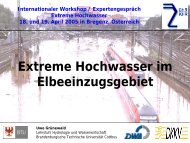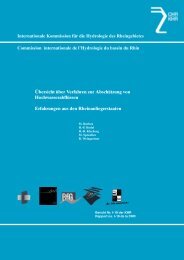ABSTRACTS 'Extreme Discharges' - CHR-KHR
ABSTRACTS 'Extreme Discharges' - CHR-KHR
ABSTRACTS 'Extreme Discharges' - CHR-KHR
Create successful ePaper yourself
Turn your PDF publications into a flip-book with our unique Google optimized e-Paper software.
Table 1: Modelled changes in water level [cm] at five main gauging stations of the Rhine, due to scenarios of<br />
land-use change and river training (river retention) measures, for three different meteorological scenarios.<br />
Explanations for land-use and climate scenarios are given in the text<br />
Rhine gauging station<br />
(km down Lake Constance)<br />
Worms (km 444)<br />
Meteorological Scenario<br />
M95 M95+ M95++<br />
D1 0 (0/0) 10 (0/10) 16 (0/16)<br />
D2 0 (1/0) 9 (0/10) 16 (-1/17)<br />
D3 0 (-1/1) -10 (-1/-9) 15 (-1/16)<br />
Kaub (km 546)<br />
D1 1 (-1/2) 8 (-1/9) 9 (-2/11)<br />
D2 1 /-1/2) 8 (-1/9) 9 (-1/11)<br />
D3 -5 (-7/3) 3 (-6/8) 3 (-9/11)<br />
Andernach (km 614)<br />
D1 0 (-1/1) 5 (-1/6) 6 (-1/8)<br />
D2 1 (0/1) 6 (-1/6) 7 (-1/8)<br />
D3 -5 (-7/2) 1 (-5/6) 2 (-6/8)<br />
Köln (km 688)<br />
D1 0 (-2/1) 5 (-1/6) 4 (-2/6)<br />
D2 1 (0/1) 5 (-1/6) 5 (-1/6)<br />
D3 -8 (-9/2) -1 (-7/6) -3 (-9/7)<br />
Lobith (km 857)<br />
D1 2 (-1/3) 2 (-1/3) 2 (-1/3)<br />
D2 2 (-1/3) 3 (-1/3) 2 (-1/3)<br />
D3 -1 (-5/3) -2 (-6/3) -5 (-8/3)<br />
In Tab 1 a summary of the model results is presented by listing the combined effects of land-use and meteorological<br />
scenarios. The modelled differences in water levels (in cm) at five main gauging stations of the Rhine<br />
are given. The non-parenthetic values are due to the combined effects of land-use change (increase of urban<br />
areas) and river training (increase of flood-discharge retention in river polders). The values in parenthesis are<br />
due to land use change only (1 st value) and due to river training only (2 nd value). Positive numbers imply a decrease<br />
in water level, negative ones imply an increase.<br />
From the differences in water levels listed in Table 1 one can draw several conclusions:<br />
- The increase of flood peak level due to a further moderate (realistic) increase of urbanised areas (D1) is<br />
very small (water level increase 2cm of less) and therefore almost negligible.<br />
- The influence of the proposed management of urban storm water results in a very limited mitigation of<br />
flood peaks (water level decrease 2cm or less) and therefore is almost negligible, too.<br />
- The effects of water retention in flood polders (between Maxau and Lobith) have a stronger but still small<br />
effect (water level decrease of 3cm of less for the M95 scenario, up to 10cm for the M95+, and up to 17<br />
67





